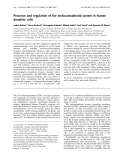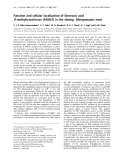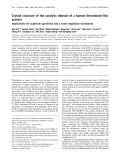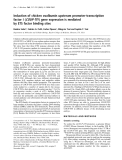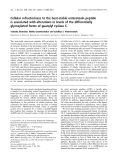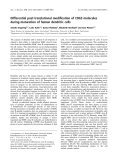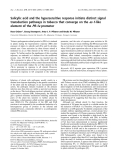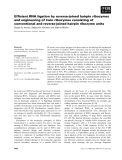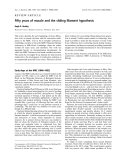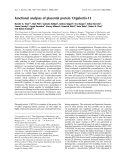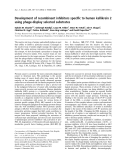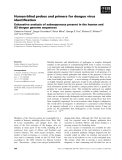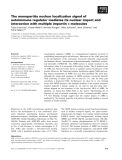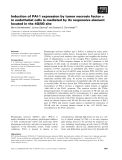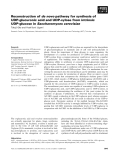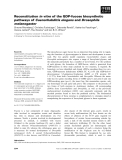
Tumor development
-
In this thesis, the author focussed on providing an application framework to be used in brain segmentation - the process of tumor detection. This constitutes setting up software bundled into a Window machine which is easily distributable. Moreover, a segmentation algorithm was implemented and tested using the provided software. In order to test the bundled software by implementing specific brain segmentation from the literature, the author used CT scans freely available from the database of 108 Central Military Hospital.
 85p
85p  capheviahe27
capheviahe27
 23-02-2021
23-02-2021
 24
24
 3
3
 Download
Download
-
AR-42, a new orally bioavailable, potent, hydroxamate-tethered phenylbutyrate class I/IIB histone deacetylase inhibitor currently is under evaluation in phase 1 and 2 clinical trials and has demonstrated activity in both hematologic and solid tumor malignancies. This report focuses on the preclinical characterization of the pharmacokinetics of AR-42 in mice and rats.
 9p
9p  caothientrangnguyen
caothientrangnguyen
 09-05-2020
09-05-2020
 20
20
 3
3
 Download
Download
-
Cannabinoid receptors and their endogenous ligands, the endocannabinoids, have been detected in several blood immune cells, including monocytes/macrophages, basophils and lymphocytes. However, their presence in dendritic cells, which play a key role in the initiation and development of the immune response, has never been investigated.
 8p
8p  system191
system191
 01-06-2013
01-06-2013
 36
36
 4
4
 Download
Download
-
The isoprenoid methyl farnesoate (MF) has been implicated in the regulation of crustacean development and reproduction in conjunction with eyestalk molt inhibiting hormones and ecdysteroids. Farnesoic acid O-methyltransferase (FAMeT) catalyzes the methylation of farnesoic acid (FA) to produce MF in the terminal step of MF synthesis. We have previously cloned and characterized the shrimp FAMeT. In the present study, recombinant FAMeT (rFAMeT) was produced for bioassay and antiserum generation.
 9p
9p  research12
research12
 01-06-2013
01-06-2013
 42
42
 3
3
 Download
Download
-
Thioredoxin is a ubiquitous dithiol oxidoreductase found in many organisms and involved in numerous biochemical processes. Human thioredoxin-like protein (hTRXL) is differentially expressed at different development stages of human fetal cerebrum and belongs to an expanding family of thioredoxins. We have solved the crystal structure of the recombinant N-terminal catalytic domain (hTRXL-N) of ˚ hTRXL in its oxidized form at 2.2-A resolution.
 9p
9p  research12
research12
 01-06-2013
01-06-2013
 43
43
 4
4
 Download
Download
-
Chickenovalbuminupstreampromoter-transcriptionfactorI (COUP-TFI, or NR2F1) is an orphan nuclear receptor that plays amajor role in the development of the nervous system. We show here that three ETS response elements in the COUP-TFIpromoter mediate its transcription. A reporter gene containing theseETSbinding sites is activatedbyEts-1, while the same reporter with point mutations on all three ETS response elements is not.
 9p
9p  research12
research12
 29-04-2013
29-04-2013
 30
30
 3
3
 Download
Download
-
Theb-amyloid peptide (Ab) is a major component of toxic amyloid plaques found in the brains of patients with Alzheimer’s disease.Abis liberated by sequential cleavage of amyloid precursor protein (APP) byb-andc-secre-tases.The level of Abdepends directly on the hydrolytic activity ofb-secretase.Therefore, b-secretase is an excel-lent target for drug design.An approach based on RNA-cleaving ribozymes was developed to control expression ofb-secretase.
 9p
9p  tumor12
tumor12
 20-04-2013
20-04-2013
 39
39
 4
4
 Download
Download
-
The heat-stable enterotoxin peptides (ST) produced by enterotoxigenicEscherichia coliare one of the major causes of transitory diarrhea in the developing world. Toxin bind-ing to its receptor, guanylyl cyclase C (GC-C), results in receptor activation and the production of high intracellular levels of cGMP. GC-C is expressed in two differentially glycosylated forms in intestinal epithelial cells. Prolonged exposure of human colonic cell lines to ST peptides induces cellular refractoriness to the ST peptide, in terms of intra-cellular cGMP accumulation....
 10p
10p  tumor12
tumor12
 20-04-2013
20-04-2013
 39
39
 3
3
 Download
Download
-
The capacity of dendritic cells to initiate T cell responses is related to their ability to redistribute MHC class II mole-cules from the intracellular MHC class II compartments to the cell surface. This redistribution occurs during dendritic cell development as they are converted from an antigen capturing, immature dendritic cell into an MHC class II-peptide presenting mature dendritic cell. During this matu-ration, antigen uptake and processing are down-regulated and peptide-loaded class II complexes become expressed in a stable manner on the cell surface. ...
 9p
9p  fptmusic
fptmusic
 16-04-2013
16-04-2013
 47
47
 3
3
 Download
Download
-
Tobacco pathogenesis-related protein 1a (PR-1a) is induced in plants during the hypersensitive response (HR) after exposure of plants to salicylic acid (SA) and by develop-mental cues.Gene activation by these diverse stimuli is mediated via anas-1-like element in the PR-1aupstream region.To further analyze the significance of thiscis-acting sequence, an authentic as-1element from the cauliflower mosaic virus 35S RNA promoter was inserted into the PR-1apromoter in place of theas-1-like motif.
 11p
11p  fptmusic
fptmusic
 12-04-2013
12-04-2013
 38
38
 3
3
 Download
Download
-
In recent years major progress has been made in elucidating the mechanism and structure of catalytic RNA molecules, and we are now beginning to understand ribozymes well enough to turn them into useful tools. Work in our laboratory has focused on the development of twin ribozymes for site-specific RNA sequence alteration. To this end, we followed a strategy that relies on the combination of two ribozyme units into one molecule (hence dubbed twin ribozyme).
 11p
11p  fptmusic
fptmusic
 11-04-2013
11-04-2013
 45
45
 2
2
 Download
Download
-
The functional expression of olfactory receptors (ORs) is a primary require-ment to examine the molecular mechanisms of odorant perception and cod-ing. Functional expression of the rat I7 OR and its trafficking to the plasma membrane was achieved under optimized experimental conditions in the budding yeast Saccharomyces cerevisiae. The membrane expression of the receptor was shown by Western blotting and immunolocalization meth-ods.
 14p
14p  awards
awards
 05-04-2013
05-04-2013
 51
51
 3
3
 Download
Download
-
This review describes the early beginnings of X-ray diffrac-tion work on muscle structure and the contraction mech-anismin the MRC Unit in the Cavendish Laboratory, Cambridge, and later work in the MRC Molecular Biology Laboratory in Hills Road, Cambridge, where the author worked for many years, and elsewhere. The work has depended heavily on instrumentation development, for which the MRC laboratory had made excellent provision. The search for ever higher X-ray intensity for time-resolved studies led to the development of synchrotron radiation as an exceptionally powerful X-ray source....
 13p
13p  dell39
dell39
 03-04-2013
03-04-2013
 45
45
 4
4
 Download
Download
-
Placental protein 13 (PP13) was cloned from human term placenta. As sequence analyses, alignments and computa-tional modelling showed its conserved structural and func-tional homologyto members of the galectin family, the protein was designated galectin-13. Similar to human eosi-nophil Charcot–Leyden crystal protein/galectin-10 but not other galectins, its weak lysophospholipase activity was confirmed by 31 P-NMR. In this study, recombinant PP13/ galectin-13 was expressed and specific monoclonal antibody to PP13 was developed. ...
 14p
14p  dell39
dell39
 03-04-2013
03-04-2013
 27
27
 3
3
 Download
Download
-
The reactive site loop of serpins undoubtedly defines in part their ability to inhibit a particular enzyme. Exchanges in the reactive loop of serpins might reassign the targets and modify the serpin–protease interaction kinetics. Based on this concept, we have developed a procedure to change the specificity of known serpins. First, reactive loops are very good substrates for the target enzymes. Therefore, we have used the phage-display technology to select from a penta-peptide phage library the best substrates for the human prostatekallikreinhK2 ...
 7p
7p  dell39
dell39
 03-04-2013
03-04-2013
 45
45
 4
4
 Download
Download
-
Reliable detection and identification of pathogens in complex biological samples, in the presence of contaminating DNA from a variety of sources, is an important and challenging diagnostic problem for the development of field tests. The problem is compounded by the difficulty of finding a single, unique genomic sequence that is present simultaneously in all genomes of a species of closely related pathogens and absent in the genomes of the host or the organisms that contribute to the sample background. ...
 11p
11p  dell39
dell39
 27-03-2013
27-03-2013
 37
37
 4
4
 Download
Download
-
Autoimmune regulator (AIRE) is a transcriptional regulator involved in establishing immunological self-tolerance. Mutations in theAIREgene lead to the development of the autosomal, recessively inherited, organ-specific autoimmune disease, autoimmune polyendocrinopathy candidiasis ectoder-mal dystrophy (APECED).
 10p
10p  dell39
dell39
 27-03-2013
27-03-2013
 42
42
 2
2
 Download
Download
-
Plasminogen activator inhibitor type 1 (PAI-1) is induced by many proin-flammatory and pro-oxidant factors. Among them, tumor necrosis factora (TNFa), a pivotal early mediator that regulates and amplifies the develop-ment of inflammation, is one of the strongest PAI-1 synthesis activators. Location of the TNFa response element in the PAI-1 promoter is still ambiguous.
 11p
11p  dell39
dell39
 27-03-2013
27-03-2013
 48
48
 4
4
 Download
Download
-
UDP-d-glucuronic acid and UDP-d-xylose are required for the biosynthesis of glycosaminoglycan in mammals and of cell wall polysaccharides in plants. Given the importance of these glycans to some organisms, the development of a system for production of UDP-d-glucuronic acid and UDP-d-xylose from a common precursor could prove useful for a number of applications.
 13p
13p  inspiron33
inspiron33
 26-03-2013
26-03-2013
 71
71
 5
5
 Download
Download
-
The deoxyhexose sugar fucose has an important fine-tuning role in regula-ting the functions of glycoconjugates in disease and development in mam-mals. The two genetic model organismsCaenorhabditis elegans and Drosophila melanogasteralso express a range of fucosylated glycans, and the nematode particularly has a number of novel forms.
 13p
13p  inspiron33
inspiron33
 26-03-2013
26-03-2013
 36
36
 3
3
 Download
Download
CHỦ ĐỀ BẠN MUỐN TÌM










